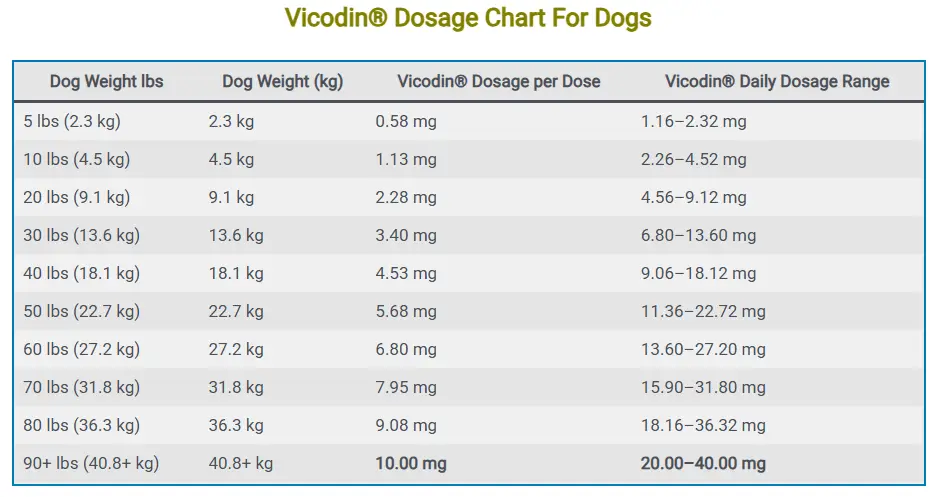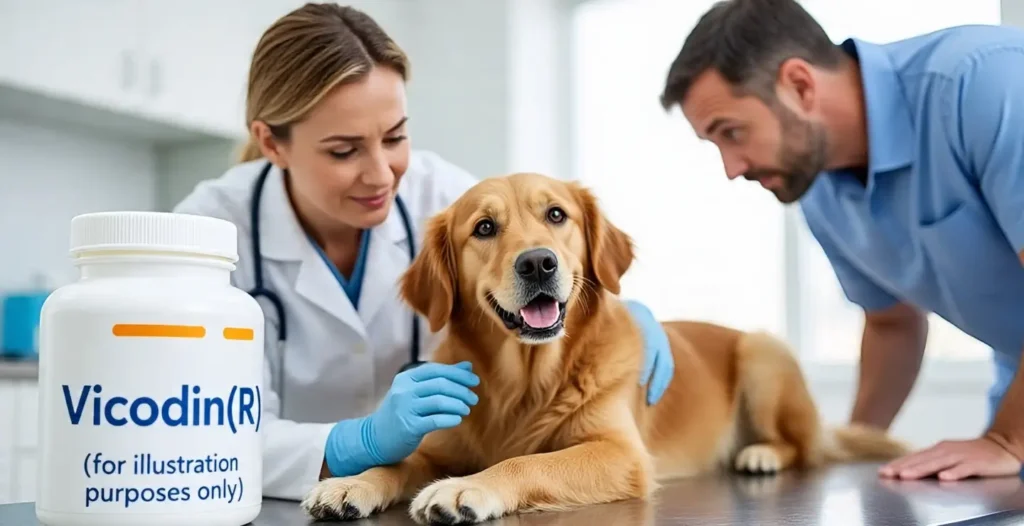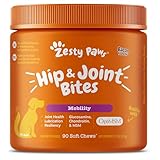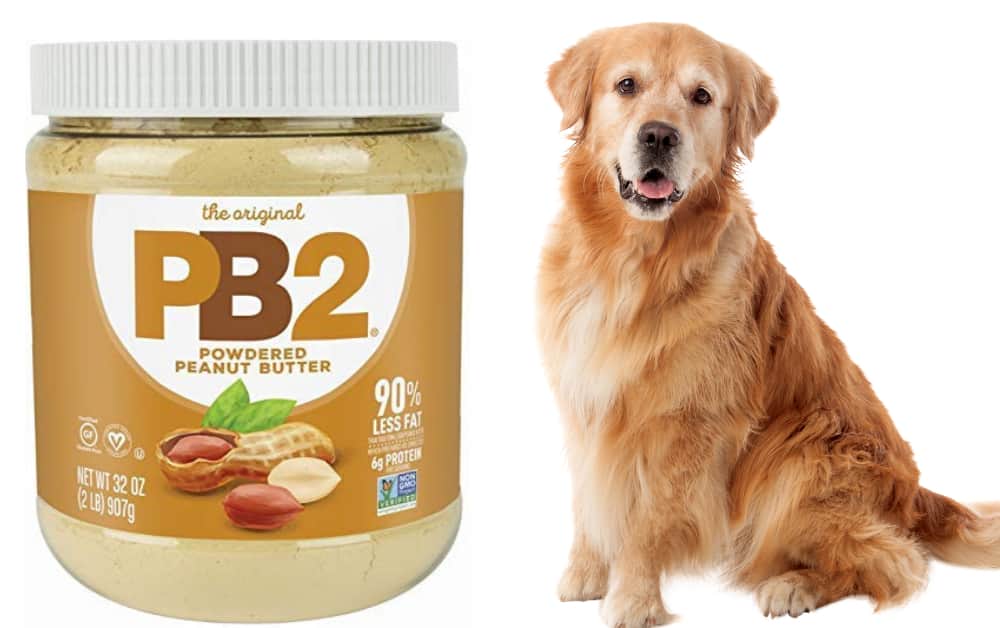Disclaimer: All the information in this guide is for educational purpose only. Before administering any medication to your dog, always consult with your veterinarian. They can recommend safer alternatives specifically formulated for canine use and appropriate for your pet’s specific health profile.
Vicodin® for dogs is a brand-name prescription medication that contains hydrocodone (an opioid pain reliever) and acetaminophen (commonly known as paracetamol). While it is widely prescribed to humans for managing moderate to severe pain, it occasionally finds its way into veterinary use—though always under strict veterinary supervision.
It’s crucial to understand from the start that Vicodin® is not a standard or commonly recommended pain reliever for dogs. In fact, its use can be very risky, and in many cases, veterinarians prefer safer alternatives specifically designed for pets.
So, why even discuss Vicodin® for dogs? In some rare and highly controlled circumstances, a veterinarian may prescribe it for a dog suffering from extreme pain that cannot be managed with other medications.
However, because acetaminophen can be toxic to dogs in even small amounts, Vicodin® is considered a last-resort medication rather than a go-to option.
The goal of this guide is to provide dog owners with accurate, detailed information on what Vicodin® is, why it’s rarely used in dogs, what dangers it poses, and what a typical dosage chart by weight might look like in theory—while stressing that only a licensed veterinarian should determine the safe dose for your individual dog.
Think of this guide as a safety manual. Many well-meaning pet parents assume that if a medication works for humans, it should work for dogs. Unfortunately, that’s not true.
Dogs metabolize drugs differently, and medications like Vicodin® can cause more harm than good if not handled properly.
By the end of this article, you’ll have a clear understanding of how Vicodin® works, when (and if) it may be prescribed for dogs, the dangers of overdose, and safer alternatives that should always be considered first.
How much Vicodin® is Safe For Dogs?
The safe Vicodin® for dogs dosage is 0.25 mg/kg administered orally (PO) every 6–12 hours under strict veterinary supervision. This canine cough suppressant and pain reliever requires precise weight-based dosing – for example, a 20-kg dog would receive 5 mg per dose (0.25 mg/kg × 20 kg). Never exceed 10 mg per dose regardless of weight.
Vicodin® Dosage Chart For Dogs
| Dog Weight lbs | Dog Weight (kg) | Vicodin® Dosage per Dose | Vicodin® Daily Dosage Range |
|---|---|---|---|
| 10 lbs (4.5 kg) | 4.5 kg | 1.13 mg | 2.26–4.52 mg |
| 20 lbs (9.1 kg) | 9.1 kg | 2.28 mg | 4.56–9.12 mg |
| 30 lbs (13.6 kg) | 13.6 kg | 3.40 mg | 6.80–13.60 mg |
| 40 lbs (18.1 kg) | 18.1 kg | 4.53 mg | 9.06–18.12 mg |
| 50 lbs (22.7 kg) | 22.7 kg | 5.68 mg | 11.36–22.72 mg |
| 60 lbs (27.2 kg) | 27.2 kg | 6.80 mg | 13.60–27.20 mg |
| 70 lbs (31.8 kg) | 31.8 kg | 7.95 mg | 15.90–31.80 mg |
| 80 lbs (36.3 kg) | 36.3 kg | 9.08 mg | 18.16–36.32 mg |
| 90+ lbs (40.8+ kg) | 40.8+ kg | 10.00 mg | 20.00–40.00 mg |
When is Vicodin® Prescribed for Dogs?
You might be wondering: if Vicodin® is so risky, why would a veterinarian ever prescribe it to a dog? The answer is that it is almost always considered a last-line treatment option. It is not a first-choice pain medication for dogs under any circumstances.
Here are some rare situations where a veterinarian might consider Vicodin®:
- Severe Post-Surgical Pain – If a dog undergoes a major surgical procedure and other pain medications are not effective, a veterinarian may cautiously prescribe Vicodin® for short-term use.
- Serious Injury or Trauma – In the case of a car accident or severe fracture, where pain levels are extremely high, Vicodin® may be used as a temporary option.
- End-of-Life Care (Palliative Use) – For dogs with terminal conditions like late-stage cancer, a veterinarian may consider Vicodin® to keep the pet comfortable in their final days.
That being said, these situations are exceptionally rare. Most vets avoid Vicodin® because there are safer alternatives such as:
- Tramadol – A weaker opioid-like drug that’s safer for dogs.
- NSAIDs (Carprofen, Meloxicam, Deracoxib, Firocoxib) – Designed for canine pain and inflammation.
- Gabapentin – Often prescribed for chronic pain or nerve-related pain.
It’s also important to note that when Vicodin® is used, it’s usually prescribed for very short-term relief—never for long-term, ongoing pain management. Unlike in humans, where Vicodin® might be taken for weeks or months, dogs typically only receive it for a few days, if at all.
As a responsible pet owner, if your vet suggests Vicodin®, don’t hesitate to ask why not use a safer option first. In many cases, alternatives provide the same (or better) relief with fewer risks.
Safety Concerns and Risks
Giving Vicodin® to dogs is like walking a tightrope—there’s very little margin for error. The risks can often outweigh the benefits, which is why most veterinarians avoid prescribing it. Here are the key dangers to understand:
1. Acetaminophen Toxicity
- Dogs cannot process acetaminophen efficiently.
- Even small doses can damage the liver, leading to hepatic failure.
- It can also destroy red blood cells, leading to a condition called methemoglobinemia, which reduces oxygen transport in the blood.
2. Hydrocodone Side Effects
While hydrocodone itself can provide pain relief, it also comes with side effects in dogs:
- Sedation or lethargy
- Constipation
- Slow heart rate
- Breathing difficulties at high doses
3. Narrow Safety Window
Unlike medications specifically designed for pets, Vicodin has a very narrow margin between “effective” and “toxic.” This means a tiny overdose can cause severe harm.
4. Risk of Overdose
Accidental overdoses are common when pet owners attempt to medicate their dogs without veterinary approval. Symptoms of overdose include:
- Vomiting
- Weakness
- Labored breathing
- Jaundice (yellow gums/eyes)
- Collapse or coma
5. Long-Term Health Risks
If given repeatedly, Vicodin® can lead to:
- Liver damage from acetaminophen buildup
- Dependency on hydrocodone
- Increased risk of gastrointestinal issues
In summary, Vicodin® is a high-risk medication for dogs, and should only be used under the strict guidance of a veterinarian, with careful monitoring for any signs of trouble.
Signs of Overdose or Adverse Reaction
Recognizing the signs of a Vicodin® overdose in dogs is absolutely critical. Because the margin of safety is so narrow, even one extra pill—or part of one—can trigger life-threatening reactions. Unlike humans, dogs don’t metabolize medications like acetaminophen effectively, which means toxic effects build up much faster. As a responsible pet owner, you should know the warning signs and be ready to act quickly.
Common Symptoms of Vicodin® Overdose in Dogs
- Gastrointestinal distress – vomiting, diarrhea, or lack of appetite.
- Lethargy and weakness – your dog may seem overly tired, unable to stand, or uninterested in normal activities.
- Labored or slow breathing – opioids can suppress respiratory function, causing shallow breaths.
- Pale or yellow gums – jaundice (a sign of liver damage) often develops due to acetaminophen toxicity.
- Swelling of the face or paws – some dogs develop swelling due to tissue oxygen deprivation.
- Brown or blue-tinged gums – a dangerous condition called methemoglobinemia can reduce the blood’s ability to carry oxygen.
- Collapse or seizures – in severe cases, overdose may lead to coma or death if untreated.
What To Do If You Suspect Overdose
- Call your veterinarian immediately. If your vet is unavailable, go to the nearest emergency animal hospital.
- Provide details – the type of medication, how much your dog ingested, and when.
- Do not induce vomiting unless instructed by a vet. Some medications can cause more harm if vomited back up.
- Bring the pill bottle with you—knowing the dosage strength helps vets respond faster.
Quick action is often the difference between recovery and tragedy. Unlike some accidental ingestions where dogs may have time to process the substance, Vicodin® toxicity is urgent. The sooner treatment begins, the better your dog’s chances of survival.
Alternatives to Vicodin® for Dogs
Since Vicodin® carries so many risks, veterinarians usually recommend safer, more effective alternatives. Thankfully, the veterinary world has developed multiple options specifically for canine use.
1. Veterinary NSAIDs
These are the most common pain relievers prescribed for dogs. Unlike human NSAIDs (like ibuprofen or naproxen, which are highly toxic to dogs), veterinary NSAIDs are carefully formulated for safety. Examples include:
- Carprofen (Rimadyl®) – often prescribed after surgery or for arthritis.
- Meloxicam (Metacam®) – a liquid NSAID for long-term pain management.
- Deracoxib (Deramaxx®) – commonly used for post-operative pain.
- Firocoxib (Previcox®) – often given for osteoarthritis.
These medications not only relieve pain but also reduce inflammation, making them highly effective for joint issues.
2. Tramadol
A synthetic opioid-like drug, tramadol is frequently prescribed to dogs with chronic pain, especially those with arthritis or cancer. It’s less potent than hydrocodone but far safer because it doesn’t contain acetaminophen.
3. Gabapentin
This drug is often used for nerve-related pain or as part of a multi-drug pain management plan. It’s particularly helpful for chronic pain conditions that don’t respond well to NSAIDs alone.
4. Steroids
In cases of severe inflammation, corticosteroids like prednisone may be prescribed. However, they’re usually a short-term solution because of long-term side effects.
5. Natural and Supportive Remedies
Some pet owners prefer complementary approaches such as:
- Omega-3 fatty acid supplements for joint health.
- Glucosamine and chondroitin to support cartilage.
- Acupuncture or physiotherapy for chronic pain relief.
While natural remedies can be supportive, they should always be discussed with your veterinarian before use.
The bottom line is clear: dogs don’t need Vicodin® when so many safer, effective pain relief options exist. Unless no other option works, Vicodin® is almost always avoided in modern veterinary medicine.
How Veterinarians Determine Proper Dosage
You may wonder why veterinarians insist on handling pain medication decisions instead of letting owners adjust doses themselves. The answer is simple: every dog is different. What works for one pet can be dangerous for another.
Factors Considered by Veterinarians
- Weight – Heavier dogs typically tolerate higher doses, but calculations must be precise.
- Age – Puppies and senior dogs process medications differently.
- Breed sensitivities – Some breeds are more vulnerable to certain drugs.
- Existing health conditions – Dogs with liver, kidney, or heart disease are at greater risk.
- Concurrent medications – Some drugs interact dangerously when combined.
Monitoring the Dog’s Response
When a vet prescribes pain medication, they don’t just send you home and hope for the best. They typically recommend follow-up visits to:
- Assess whether the medication is working.
- Check for signs of toxicity or side effects.
- Adjust the dosage or switch medications if needed.
Why You Should Never DIY Dosage
Even well-meaning dog owners can make mistakes. For example:
- Splitting a pill incorrectly could result in too much acetaminophen.
- Guessing dosage by weight alone ignores individual health differences.
- Using leftover medication from one dog on another can be very dangerous.
This is why veterinary expertise is non-negotiable when it comes to pain medication. Proper dosing requires more than just a chart—it requires a professional assessment of the whole dog.
You May Also Like To Read:
FAQs
Can I give my dog Vicodin® at home without a prescription?
Absolutely not. Vicodin® is not approved for veterinary use in dogs without direct supervision from a licensed veterinarian. The risk of liver failure, overdose, or respiratory suppression is far too high. Even if your dog is clearly in pain, giving human medication without veterinary approval can do more harm than good. Instead, call your vet and ask for safer, dog-specific alternatives.
What should I do if my dog accidentally ate Vicodin®?
This is a medical emergency. Contact your veterinarian or the nearest animal emergency hospital immediately. If possible, note how many tablets your dog ingested and when. Do not attempt home remedies like inducing vomiting unless explicitly instructed by a vet—sometimes this can worsen the situation. Quick veterinary treatment can save your dog’s life.
How long does Vicodin® last in dogs?
In the rare cases when Vicodin® is prescribed under veterinary care, its effects typically last 6 to 12 hours, depending on the dog’s size, age, and metabolism. However, because the risks are so great, most veterinarians prefer safer medications that are easier to dose and monitor.
Can Vicodin® be combined with other medications?
Mixing Vicodin® with other drugs is extremely risky. Hydrocodone can interact with sedatives, antidepressants, and other painkillers, intensifying sedation and suppressing breathing. Meanwhile, the acetaminophen component can interact dangerously with other liver-metabolized drugs. Always disclose all medications and supplements your dog is taking before your vet prescribes anything new.
What’s the safest alternative to Vicodin® for dogs?
The safest pain relief options are medications made specifically for dogs, such as Carprofen, Meloxicam, Deracoxib, or Firocoxib. For chronic pain, Tramadol, Gabapentin, or joint supplements may be better suited. Ultimately, your vet will decide based on your dog’s weight, age, health history, and specific condition.











![Can Dogs Eat Blood? 7 Side Effects [Expert Opinion]](https://petskor.com/wp-content/uploads/2022/04/Webp.net-resizeimage-12.jpg)
